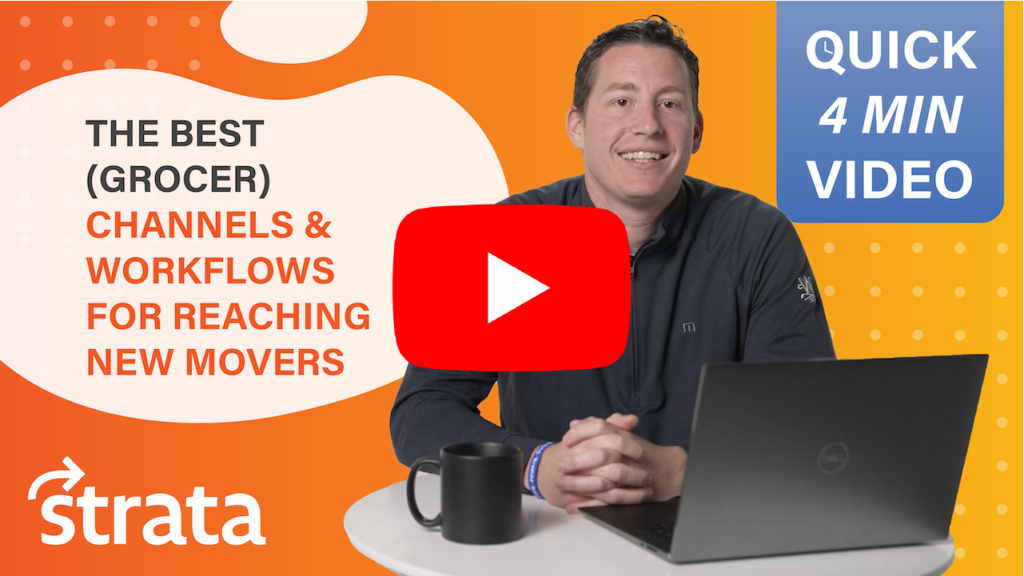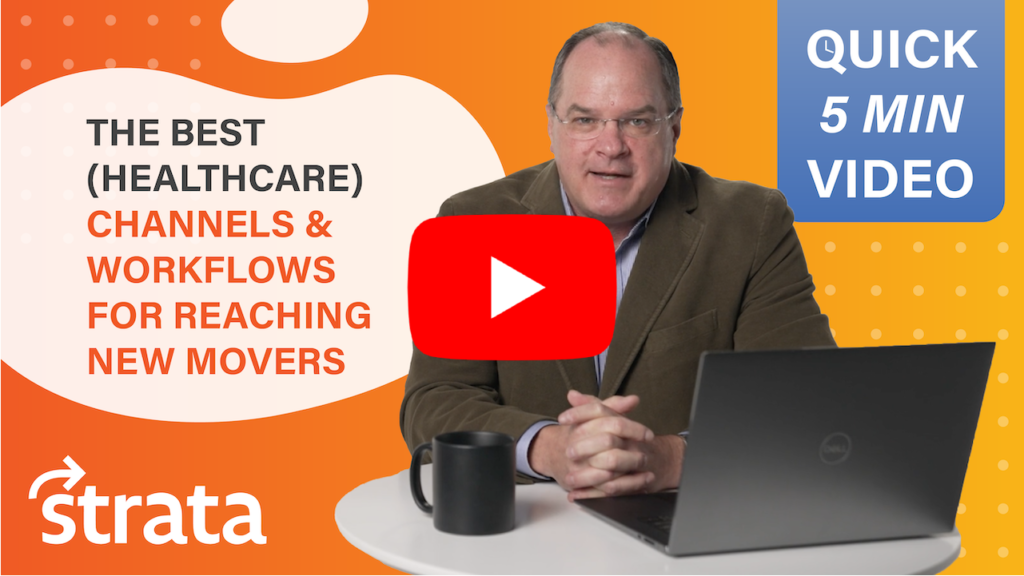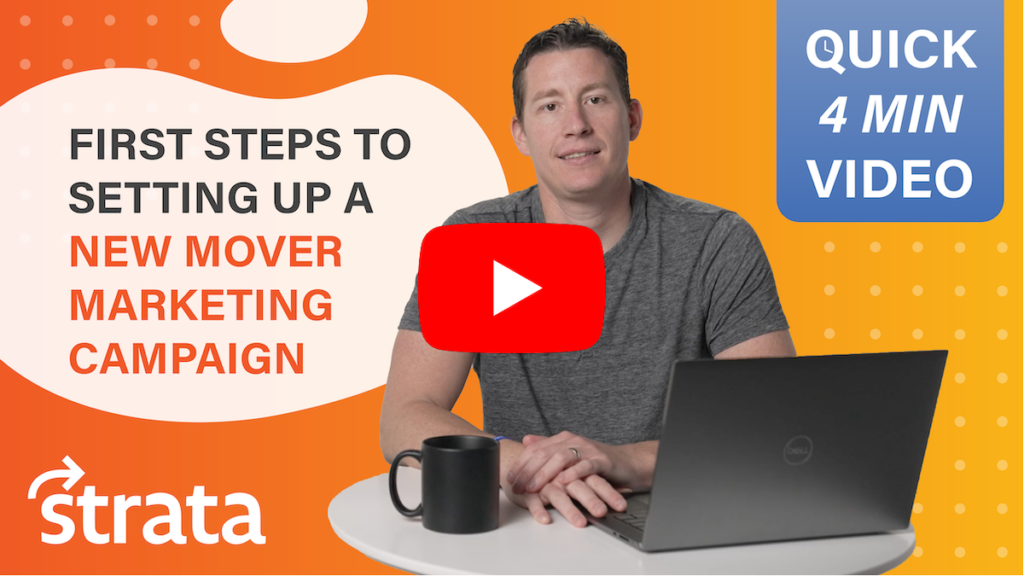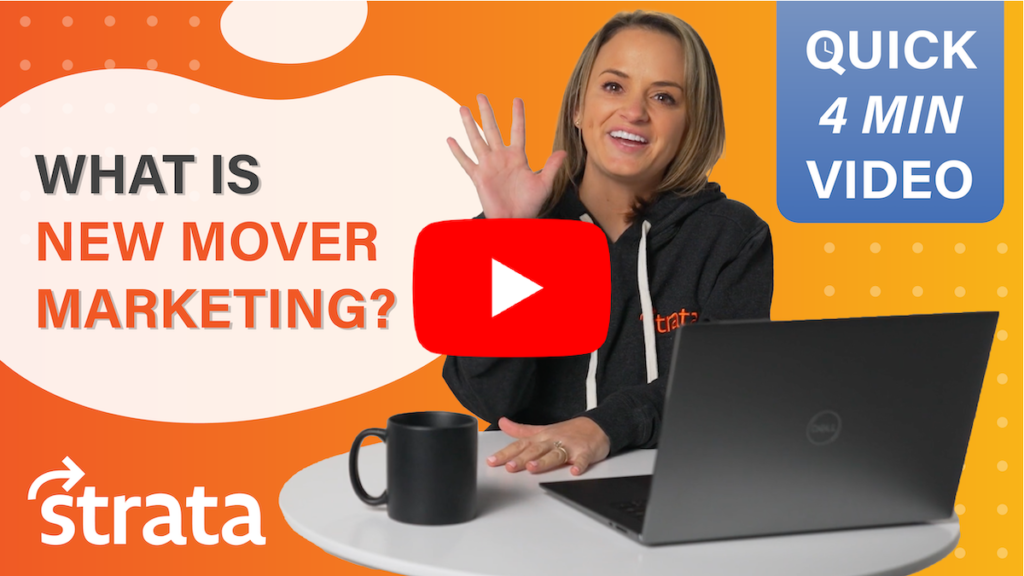A Strata YouTube Channel Original
In our last few blogs (and their corresponding YouTube videos) we’ve gone over the basics of new mover marketing, how to choose the right partner, and some steps to get started. Now, it’s time to take a deeper dive into how you can specifically utilize new mover marketing in the grocery industry and what channels and workflows work best.
A Quick Review of New Mover Marketing
To give you a brief refresher, new mover marketing is a specific, niche marketing tactic that’s designed to reach new residents in your area. It’s one of the most effective ways to bring in new customers that have just recently entered your specific target market. When it comes to new movers, they’re nobody’s customer, yet – so it’s an effective tactic to make a good first impression at the same time they’re looking for your product or service.
What do New Residents Really Want?
To answer the question, new residents are looking for “reliables”. These are goods and/or services that new movers can depend on daily, weekly, monthly, or even yearly. Since they’re new to the area, they’re usually unsure where to start. When it comes to grocery stores, sometimes there can be almost too many options for consumers to choose from. Because of this, you, as a grocery store, are in constant competition with other stores near you. That’s why it’s so important for your grocery store to be the first to reach out and make the consumer aware of your store – before competitors – and show them you’re close by. With immediate outreach, they’ll see you care, are convenient, and have quality goods.
The Best New Mover Channels for Grocers
We’ve deemed ourselves experts in new mover marketing all around – and we’re very practiced in some of the best channels and workflows for grocers (specifically) to reach new movers. One of the best channels you can take advantage of is direct mail. We know direct mail to be vital to the success of new mover campaigns, especially those of grocery stores. When mail is executed correctly, with personalization and attribution tactics, it can cut through all the digital noise and stand out in the mailbox. As we’ve mentioned in past blogs and videos, the average response rate for direct mail can be up to 50% more effective than those of email blasts, so it’s definitely worth your time and money!
Like we hinted at above, not all direct mail is created equal, so we suggest that those in the grocer industry send a “welcome handshake”. This is either a 6×9 or 6×10 postcard or bifold that allows your store to be introduced and represented in the best way possible. Again, the key to a good direct mail campaign is making sure it’s personable and actionable. With personalization and calls-to-action, you can welcome new movers to the neighborhood by first name and provide a personalized offer, which they can access by QR code or PURL. Another option? Provide a personalized coupon that they can redeem in-store, upon their first visit. If you want to go a step further in terms of personalization, include a map that shows the location of your store relative to their new residence. Generally, you want to make it as easy and enticing as possible for new movers to choose and visit your store.
What’s Next?
With this quick read, you now have a look into one of the top grocery industry channels to utilize for your next new mover campaign. But – it doesn’t stop there! We still have more suggestions when it comes to the best channels and workflows for grocery establishments like yours. Head over to our YouTube channel, where you’ll hear these suggestions from Connor, a member of Strata’s Strategic Sales Team. Or, if you’re ready to take these new mover marketing steps with Strata, contact us today.
A Strata YouTube Channel Original
In our last three blogs (and their corresponding YouTube videos) we’ve gone over the basics of new mover marketing. It’s important to remember that new mover marketing can differentiate between industries, so the best plan of action for specific business types may not be the same as others. In this blog and its corresponding YouTube video, we’re taking a deep dive into how you can specifically utilize new mover marketing in the healthcare sector – as well as what channels work best.
A Quick Refresher on New Mover Marketing
To give you a brief refresher, new mover marketing is a specific, niche marketing tactic that’s designed to reach new residents in your area. It’s one of the most effective ways to bring in new customers that have just recently entered your specific target market. When it comes to new movers, they’re nobody’s customer, yet – so it’s an effective tactic to make a good first impression at the same time they’re looking for your product or service.
What are New Residents Actually Looking For?
To answer the question, new residents are on the lookout for “reliables”, which are goods and services they can depend on daily, weekly, monthly, or even yearly. The healthcare industry is full of these “reliable” services – and these services are much different than those of grocery stores and restaurants. Customers will more likely choose any grocery store or restaurant to at least check out and maybe turn into their new “go-to” spot. If it ends up that they don’t like the spot – it’s really no big deal. They’ll move on and find another. With healthcare, most people don’t want to “try out” 4 or 5 doctors/healthcare services until they find one they like. In general, it’s a lot more work to fill out paperwork and questionnaires at healthcare offices, and most people only want to do that once.
Potential patients want to feel important and valued, so it’s key to be the first to reach out. When you reach out – first, the potential patient can get to know you and your system, while ensuring that you’ll be there in their times of need.
Best New Mover Healthcare Campaign Channels
Based on our years of expertise and data collection, we’ve compiled a list of what we think are the best channels to utilize when reaching out to new movers to hopefully turn them into patients. The first channel we recommend utilizing is direct mail. The average response rate for direct mail can be up to 50% more effective than that of an email blast, when done correctly. For a direct mail campaign to be done correctly, there must be some aspect of personalization, multiple response vehicles (such as QR codes and PURLs) and accurate data lists. The key to quality, effective direct mail is incorporating more than one touchpoint. If you’re able to send more than one direct mail piece, your potential patient will be consistently reminded of you and your business.
The next channel we recommend utilizing? Digital advertising. Targeted, focused ads can show potential patients that you’re close by and welcoming new patients. A benefit to using digital advertising? The level of precision. With digital ads, you can measure performance through impressions served and ad clicks. If you pair with the right new mover marketing partner for your business, you’ll be able to see how many and which customers converted due to your digital ads. This real-time data is vital to the success of your campaigns. It allows you to see what campaigns are working, which ones are not, and make the necessary adjustments on the fly rather than once the campaign is over.
What’s Next?
You now have some potential, optimal channels to utilize as a part of your next new mover campaign. But it doesn’t stop there! We still have more suggestions. Head over to our YouTube channel (by clicking the thumbnail below) to hear from Rob, a member of Strata’s Strategic Sales Team. He’ll fill you in on the rest of our channel recommendations. If your healthcare system is ready to take these new mover marketing steps with the team at Strata, contact us today.
A Strata YouTube Channel Original
In our past two blogs and their connected YouTube videos, we’ve given you a ton of basic information on new mover marketing. Now, it’s time to get into the first steps of starting a new mover marketing campaign. If you’re not super familiar with new mover marketing, it can be difficult to determine where and how to start, but we’ll lead you through the first things to do and ensure you’re well prepared.
A Quick Refresher on New Mover Marketing
To give a brief refresher, new mover marketing is a specific, niche marketing tactic that’s designed to reach new residents in your area. It’s one of the most effective ways to bring in new customers that have just recently entered your specific target market. When it comes to new movers, they’re nobody’s customer, yet- so you must make a good impression at the same time they’re looking for your product or service.
First, Answer the Question – Is a New Mover Campaign Right for Your Company?
New mover marketing is continually gaining popularity, and fast. It’s currently up 3% since last year, despite any economic rough patches. Why? Because people are always moving. Whether it’s for a new job, family changes, the need to start fresh, or anything else – and that will never change. When someone moves to a new area, they’re almost solely focused on unpacking, organizing, and settling in. They’ll heavily rely on word of mouth (WOM) marketing and other advertising to learn and figure out all their new go-to spots.
However, all this doesn’t mean that new mover marketing is fit for every business. It’s important to realize how (and if) your business can benefit from new mover marketing, and when another type of campaign would make more sense. At Strata, we typically say that if your product or service is needed within the first 6 months of a move, you should be targeting new movers. Anything within that 6-month mark would be something that new movers need in their day-to-day lives after a move. For example, think grocery stores, dentists, vets, salons – the list is endless. On the flip side, anything after that 6-month mark will typically be something they already own/have and are looking to buy new, now that they’re settled in. A good example of this? A new car. The majority of people don’t move to a new town and automatically search for and buy a new car. New mover marketing is all about the new movers’ priorities, so it’s important to understand where your business falls within those priorities.
Start with the Right Data
The use of data is incredibly important for new mover marketing, but it’s even more important to target the right people rather than all the people. You want your efforts to pay off – so sending new mover campaigns to residents who’ve already been established for years or have moved within the same zip code will more than likely be a waste of your time (and money). Sometimes, a smaller list will produce higher ROI, since you’re targeting actual, definite, new movers. Make sure you work with a reliable and well-versed company to ensure quality data over quantity of data. To learn more about the importance of quality over quantity, check out this blog.
What’s Next
Now you have the first few steps to starting your new mover campaign – but don’t stop there! In the video below, Connor, a member of our Strategic Sales Team at Strata, will go into the next set of steps you’ll take to create the best new mover marketing campaign possible. Check out the video by clicking below, and if you’re ready to take these first new mover marketing steps with Strata, contact us today.
Untrue & Debunked
With years of experience, we’d say we’re experts in direct mail marketing. But we’re not just the mail people. We provide highly impactful direct mail marketing that cuts through today’s digital noise to deliver a tactile experience and leave a lasting impression. That’s why we’re well versed in all of the misconceptions about direct mail floating around out there, and can tell you exactly why they’re untrue. Follow along as we debunk the 6 misconceptions of direct mail.
Misconception 1: Direct mail is past its heyday
Once in a while, we hear people speculate and assume that direct mail is past its peak – but just because direct mail has stood the test of time, doesn’t make it outdated. It’s been around for a while for a reason, and has evolved and changed over time – with the times. In fact, in a recent IAB survey, six out of ten marketers prefer direct mail over other offline channels and still include it in their direct marketing strategy today.
These days, direct mail breaks through the digital noise and is unique and different than other marketing tactics. It brings about nostalgia, as people enjoy the feeling of paper in their hands, similar to enjoying paperback books over kindles. Plus, for every 36 emails you receive (on average), you get 1 piece of mail in your mailbox. The possibilities are quite endless, with many exciting design opportunities and options. Really, direct mail is only boring and old if you make it that way.
Misconception 2: Compared to other tactics, direct mail doesn’t provide ROI
This one couldn’t be further from the truth. Don’t believe us? Here are just a few stats to back us up. The average lifespan of an email is 17 seconds, compared to direct mail’s average lifespan of 17 days. Up to 90% of direct mail gets opened, compared to only 20-30% of emails. Per USPS, 98% of people check their mail daily and Americans spend upwards of 30 minutes with their mail on a single occasion. Direct mail open rates can reach up to 42%. Recipients of direct mail also “purchase 28% more items and spend 28% more money than people who don’t get that same piece of direct mail.” Direct mail gets response rates 10 to 30 times higher than digital channels, according to the DMA (Direct Marketing Association).
Basically, direct mail usually does very well in terms of ROI, and it can (and should) be tracked – so make sure you’re getting the most out of it by making it trackable with the use of digital touchpoints.
Misconception 3: Direct mail marketing is expensive
When people think of print, they sometimes think of high-cost, but that’s not always the case. If you have a quality list and are getting the most out of each mailer you send, direct mail won’t seem all that expensive. What do we mean by a quality list? If you’re sending to strategic, particular contacts – not just any contacts, your ROI will be worth the price.
Additionally, print often gives you more for your money while other marketing practices alone may not (for example PPC, social media ads, email marketing platforms, and more). According to the stats, mail marketing is much more likely to be seen and paid attention to.
Misconception 4: Millennials and younger don’t like or pay attention to direct mail
Direct mail isn’t just effective for older audiences. Actually, 73% of American consumers (in general) say they prefer being contacted by brands via direct mail because they can read or review the information at their leisure. And, 41% of Americans of all ages look forward to checking their mail each day.
Millennials, specifically, like to feel important and seen, so the personalization opportunities of direct mail make for great millennial marketing. To add to this, many millennials and Gen-Z-ers have digital fatigue and find taking a “break” with print to be often enjoyable, and it “should be no surprise that those raised on the internet are best able to tune out online ads.” They also have shown to have a lot more trust in print resources than in digital.
Misconception 5: Direct mail works on its own and doesn’t integrate with other channels
These days, direct mail is actually an excellent touchpoint among many, especially when conducting a multichannel marketing campaign. And, we’d even say that combining tactics, even if it’s just two, is usually the way to go. In a recent study, a whapping 68% of marketing respondents saw that combining digital and direct mail increased visits to their websites.
So, how do you integrate physical with digital? By using a URL of a landing page or website, a PURL (personalized URL), BRC (business reply card), or a QR code. Any of these can be used to lead the viewer to a digital touchpoint. These can all also be used to measure attribution and better understand your target audience, and the emails and other information acquired from BRCs or online landing page forms can be used for email marketing, targeting customers with digital advertising, and sending further communication.
Misconception 6: Direct Mail = Junk Mail
Unlike junk mail, direct mail is focused, targeted, relevant, ROI-producing, and uses a quality send list. For more on why direct mail isn’t the same as junk mail, check out our blog, “Direct Mail vs. Junk Mail”, here. Strata can be a resource for direct mail with a surgically targeted list of prospects that are not only more likely to have a need for your project or service, but are also more likely to respond.
Now that it’s a bit clearer that direct mail is relevant, effective, and can be a huge part of the bigger picture of a marketing strategy, you may be interested in giving direct mail marketing or multichannel marketing a try. If so, give us a call.
A Strata YouTube Channel Original
In one of our recent blogs and its connected YouTube video, we went over the basic ideas behind new mover marketing. Now you may be thinking, what do I do with all this information? The next step is choosing the right new mover campaign partner. It can be overwhelming deciding on a marketing or new mover business that’s right for you to partner with. Luckily, we’ve compiled a list of all the different qualifications you should be looking for in a partner.
What’s New Mover Marketing Again?
As a quick reminder, new mover marketing is a specified, niche marketing tactic that’s designed to reach new residents in your area. It’s focused on bringing in new customers that have recently entered your target market. Why’s it so important – and furthermore, why does it work? It helps your company make a strong first impression at the same time someone is looking for your service.
The Qualities that Make a Good Partner
You don’t want to just choose a random new mover partner or even the first one you stumble upon. It’s important to put thought and consideration into your choice, so that you can make the best decision for your business. Make sure your partner has a bit of background on your company and understands your budget, time, size, and end goals. Remember, what you put into your search is what you’ll get out of it.
What if I Still Don’t Know Where to Start?
While you might have tons of information in front of you, deciphering this information and sifting through it all can be difficult and overwhelming. Here are a few things to do to make your search just a bit easier.
First, figure out the size of your industry, how sales have been, and what goals you want to set. All of this will allow you to pick a business that’s best suited for your type of company. The more information you can collect, the easier it’ll be to compare the strengths and weaknesses of each potential partner.
Additionally, you’ll definitely want to choose a partner that has a focus on lists and good data. This data should include demographics, psychographics, behavioral, and business-to-business firmographic information. The more specific data you can get, the better you’ll be able to target new movers and bring in more loyal customers!
While all this might seem like a lot to tackle, it’ll be worth it in the end when you have successful and effective new mover marketing campaigns.
Next Steps
You now have a baseline of how to choose the right new mover campaign partner for your business, but it doesn’t end there! Be sure to watch the video below, where you’ll hear from Rob, a member of our Strategic Sales Team at Strata. He’ll explain choosing a partner that best represents your business, in a bit more depth. Or, if you’re ready to choose your next new mover campaign partner and think it may be Strata, contact us today.
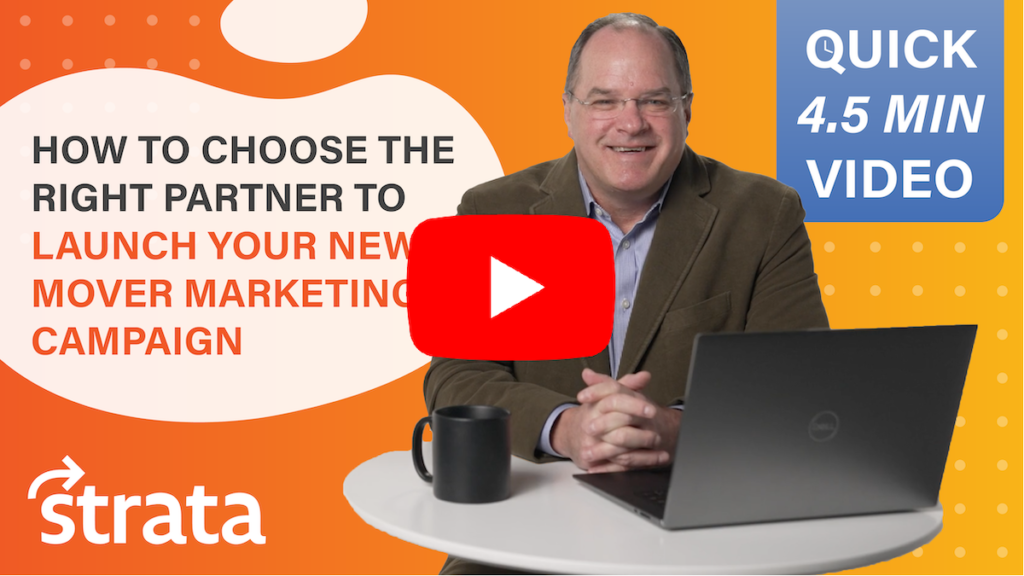
A Strata YouTube Channel Original
New mover marketing is all the rage right now, and for good reason – but getting started can be a bit confusing if you’re new to the game. That’s why in this blog, along with in our most recent YouTube video, we’ll help you achieve a clear understanding of what New Mover Marketing is, and how it could be used for your business. First, we’ll go over how new mover marketing is defined, what a new mover is, and how this marketing technique can be utilized to reach and acquire new customers.
What’s a “New Mover”?
In general, a new mover is someone who’s recently moved to your area, and since they’re new, is looking for a new doctor, dentist, grocery, vet, and more, to establish trust in – and hopefully frequent.
Is New Mover Marketing the Same as Regular Marketing?
In short, no! New mover marketing is a specified, niche tactic that helps you reach new residents in your area while they’re actively establishing new routines and purchasing habits. It’s all about making a strong, quality impression at the same time someone is looking for your services. Different than regular marketing – where you’re mostly informing current customers about new products, services, or promotions, new mover marketing tactics focus solely on bringing in new customers that have just entered your target market.
The Importance of New Mover Marketing
New mover marketing is one of the best ways to gain and retain more customers. If you really think about it, new movers have no customer loyalty to any specific business – yet. They tend to be more receptive and open-minded to marketing campaigns from any business in their new area. They’re also more likely to listen, and are easily attracted to the first business that reaches out to them (so you need to act fast)! Yet, don’t act too fast, because it’s also important to market yourself correctly and effectively. Remember, you typically only get one shot at a first impression, so make sure you present your business the right way.
Let’s quickly go through an example of how exactly a new mover marketing campaign helps you attract new customers. Suppose a new family moves into your town. They’re unfamiliar with what services/businesses are available. Soon after move in, they see a mail campaign for your grocery store in their mailbox. Because they’ll (sooner rather than later) need to go get some groceries, they may be more inclined to visit your store instead of another because you reached out and introduced your store and its services, first. As long as you market yourself correctly, you now have a new, and potentially loyal, customer!
Next Steps
With new mover marketing, the opportunities are endless! Be sure to watch the video, below, to dive a bit deeper. You’ll hear from Strata’s Director of Marketing, Caitlin, as she goes through more specifics. Or, if you’d like to get started on your next new mover marketing campaign and discuss this concept with one of our experts, contact us today.
How to Fight it & Flourish
As spooky season approaches and Halloween is around the corner, we’re thinking a lot about our biggest fears. But today we’re not talking about ghosts or goblins or even Michael Myers. We’re talking about one of the scariest things of all to any workplace…complacency.
“Complacency is man’s biggest weakness. It creeps up on us when we least expect it.” – Jay Mullings
Even if you think your company isn’t anywhere near complacency, there’s still always room to evaluate and grow. And, you may be surprised by what’s lurking behind the door of contentment. Complacency is not only bad for your company, but good for your competition, which we’d assume will give you a bit of a fright. If employees aren’t challenged to improve, things are the way they are because it’s the “way they’ve always been”, and the company isn’t growing, it’s definitely affecting your revenue. But don’t worry – it’s never too late to change. In this blog, we’ll take a look at the best ways to avoid company complacency and ensure you’re periodically updating and enhancing your culture, practices, and marketing.
Complacency’s Cause
Complacency can sneak up on any company without warning, shielding it from growth and stifling creativity and innovation. Why? Because if companies are seemingly doing “fine” and meeting their goals on paper, they feel no “need” or urgency to change. That’s where the biggest mistake is made, because companies should always be looking to evolve and thinking about their vision for the future. If not, ideas become stale, talent becomes bored, and eventually, the company comes to a jarring halt without any clue of how they got there.
When everything seems to be going well, it can be difficult to disrupt successes. And it may feel like the right decision to let processes and practices take their course rather than think about next steps and development, but often “the riskiest thing we can do is just maintain the status quo.” Without urgency and consistency for change, employee performance shifts and can even decline. Statistics show that only 30% of employees in America are actually engaged in their work, and only 13% of employees worldwide are engaged in their office environment. With such low numbers already, it’s so important to keep employees excited, energized, and motivated for what they’re doing and what’s to come.
Combatting Complacency
With complacency being a bigger, scarier possibility than you may have assumed, it’s important to keep it top of mind and to make sure you’re doing your best to combat it. Start with communication of your company’s mission, vision, and values. Make sure they’re clear, known, and maybe most importantly – accurate and true. Know who you are. If you do – your employees will too, and in turn they’ll feel more connected with and motivated by your workplace. Allow employees to see their contributions to the bigger mission, and their worth as an asset to the overarching vision.
After all, having a good (and growing) company culture is key to combatting complacency and ensuring workplace satisfaction. How do you improve your culture? Many ways, but the most effective tools are company newsletters, employee highlights, group meetings, and employee appreciation. Again – make your employees feel valued, and they’ll more likely provide value.
Additionally, make sure team members feel important and part of the greater whole. Encourage managers and team members to communicate within their individual teams, and make sure responsibilities are delegated and well distributed. Employees are more likely to become bored when they’re doing the same tasks over and over, so give them room to be creative and explore new opportunities. You never know who may have the next best idea.
Lastly, be prepared for whatever may come your company’s way, and never be too afraid to challenge the status quo. If we’ve learned anything these past two years, it’s that anything can happen, and that the saying “it won’t happen to us” is just not realistic. It’s important to listen to the ideas of your employees and always be prepared for what’s to come with an open communication structure. Make sure you have multiple decision makers, not just one, and that employees feel comfortable enough to make some decisions without “permission” from a leader. Training your employees to make decisions on their own will be a key factor in combatting complacency.
Refreshing Without Fear
Almost as important as your workplace and its people is your brand and marketing. Without change and evolution, your marketing can quickly become out-of-date right under your nose (causing your employees to lack company pride and your audience to lose interest). But how do you know when it’s the right time to update your brand and marketing?
A sure sign (these days) of lack luster marketing is an absence of social platforms. Some would even say if you’re not online, you might as well not exist. And although we think that sounds a little spooky, we’ll admit that it holds some truth. If you’re hard to find and not posting relevant content and imagery, target customers may be choosing your competitors (who are more accessible and approachable) over you.
Also important to your brand and its relevance is your website. In this day and age, it’s very easy to tell when a website has been left alone so long that it’s developing cob-webs. If you’re finding that your website traffic is down and your customers aren’t interacting with it, it’s time for an upgrade. But, before any big changes, compile data and make purposeful decisions. What is your audience looking for? What do they respond well too? How can you quickly and easily get them to have interest in your company and purchase goods?
Additionally, make sure you keep your advertising and customer communication – whether digital or physical – energized and creative. Combine direct and digital marketing to reach specific audiences and keep your brand top of mind. Don’t settle for just one medium that “seems to be working” if multiple channels of communication could bring you more success.
Lastly, avoid complacency by focusing on helping the customer rather than selling to them. While the overall goal of most companies is to generate sales, it’s essential you show your customers that you care about their pain points and needs. To see all of these tactics in action, check out our recent blog on how to create successful marketing campaigns.
Company complacency can sneak up on you like a ghost in the night and lead to missed opportunities, poor customer service, and disengaged employees. Stay aware of the possibility of contentment and make sure you’re always exploring, evolving, and rising above the rest. Change is inevitable, but complacency doesn’t have to be.
For more information on what we do at Strata and how we can help you fight complacency with one of our marketing solutions, contact us today.
A Look at Some of Our Favorite Customer-Focused Campaigns
Although we could write several blogs about all the great marketing campaigns that inspire and motivate us to be the best marketers possible and make the most effective material – in this blog, we’re looking at a few that we really admire because of how relatable and real they are. We’ll be breaking them down, thinking through what made them so successful, and in turn – helping you brainstorm your next campaign. Follow along as we dive into these customer-centric campaign leaders.
Apple’s #ShotoniPhone Campaign

No matter where you’re located – you’ve likely seen this one around town. On billboards, buses, signs, or online. iPhone and Apple’s popularity is pretty known, but what we didn’t know when the iPhone first became popular was that it would eventually completely replace the digital camera. And that’s what this campaign shows; that you can take photos with your iPhone that are as beautiful as a camera that would cost you thousands. That’s great and all, but that alone would not convince people of today. So, why’s this campaign so successful? It gets real people involved. It’s relatable. The photos are not only from real Apple customers – but include their names. If someone wanted to, they could look up the name of the person in the bottom corner associated with taking the photo and learn more about who that person is. The best part? Not all of these people are photographers, showing that anyone could use the iPhone to take great photos. This tactic is pretty genius and builds trust – as no one would really care if it was simply a generic photo that easily could have been taken on a Canon. “According to various studies, over half (51%) of Americans trust user-generated content more than other information on a company website and claim that it influences what they buy and where they buy it from.”
Coors Light’s #CouldUseABeer Campaign
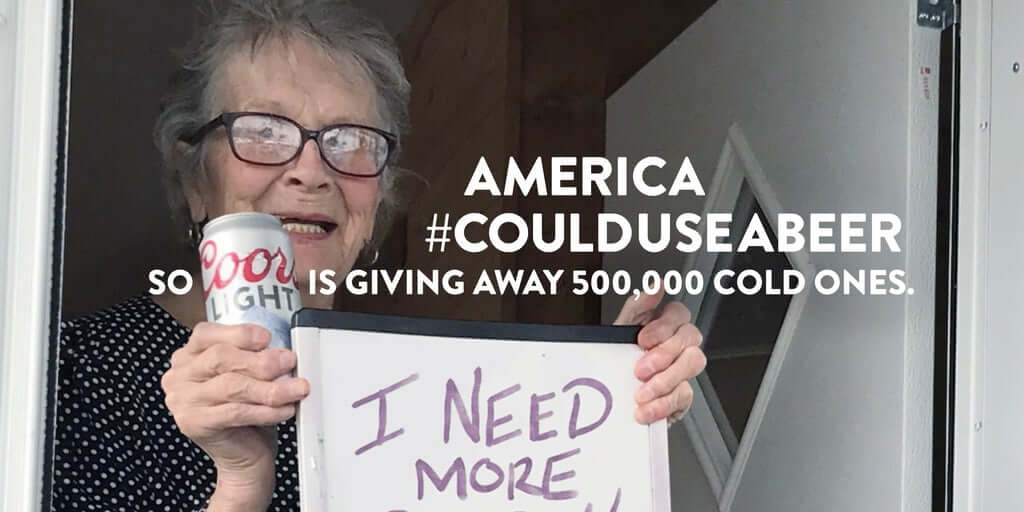
Another campaign that spoke to the general public and got them involved during a difficult time? Coors Light’s #CouldUseABeer. After a photo of a quarantined, 93-year-old woman asking for a beer went viral, Coors Light engaged with its audience by offering free six packs to anyone who was tweeted about (who – you guessed it, could use a beer). This tactic of giving away free items may seem pretty crazy, but it can go a long way. Although Coors Light gave away over 500,000 beers, their name was tweeted about again and again, which led them to trend, and boosted their reputation in a time of need.
American Apparel’s Direct Email Marketing
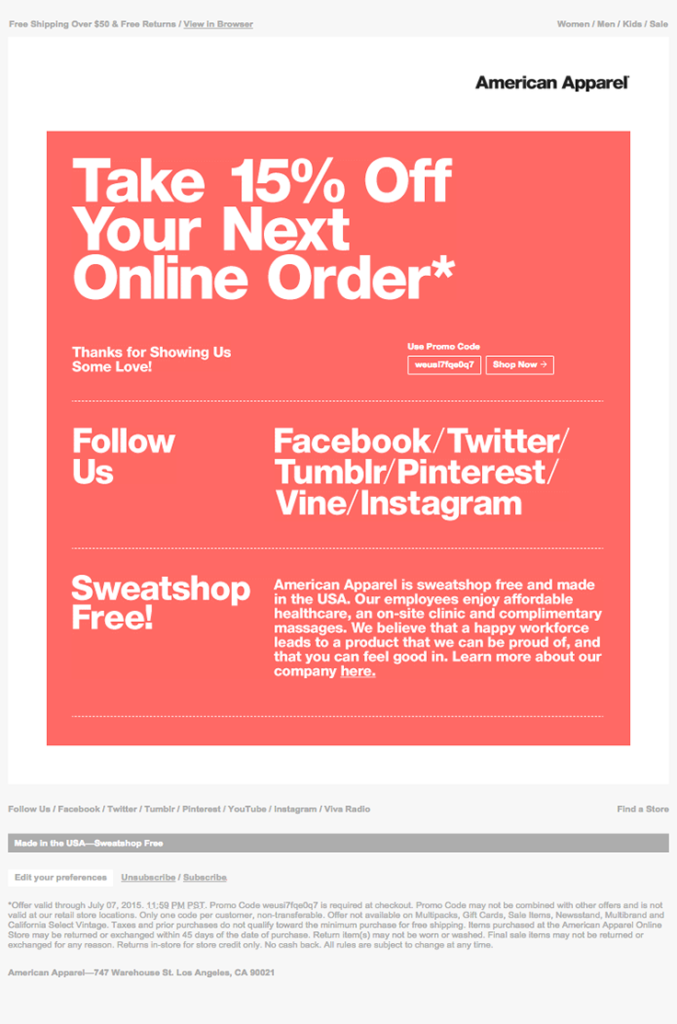
Known for being trendy and modern, American Apparel is no stranger to effective, up-to-date, customer-centric marketing. We’re specifically impressed with their to-the-point email marketing. No frills, no fluff – just what the customer wants (sales, discounts, and freebies). American Apparel always ensures that there’s no guesswork for their customers. Simple and sleek, their emails are call-to-action forward without being in-your-face.
Mercedes’ “Like You” Campaign

How do you relate a high-end brand to a broader audience of customers? Relate it to them, literally. Mercedes’ “Like You” campaign did just that. Called to several different types of audiences with phrases like, “Detail-obsessed, like you”, “Groundbreaking, like you”, “Original, like you” and “Curious, like you”. And not only was this phrasing compelling, but consistent. For the span of the campaign, potential customers could find the phrasing on billboards, signs, online ads, and on tv. The consistency was key, in that potential customers began to associate themselves with the brand and possibly even buy a Mercedes.
Airbnb’s Use of User Generated Content

Similar to Apple’s tactic, Airbnb uses the photos, videos, and feedback of its customers in its campaigns to promote beautifully classic or uniquely interesting places to stay. “Millennials spend 30% of their media time (5 hours/day) engaged with user-generated content (UGC). Coincidently, this is the same generation that drives Airbnb’s success in the sharing economy.” Airbnb keeps things personal and personalized by including its audience, which facilitates a happy and loyal community of customers.
Coca Cola’s Share a Coke Multichannel Campaign
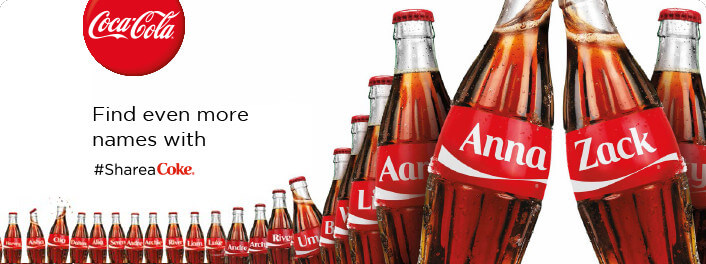
We all know this one. There’s nothing more personal than having your own name on a Coke bottle – which is exactly what Coca Cola did for its ongoing “Share a Coke” campaign. Whether you customize your bottle or simply find your name in store, you’re likely to share it with the world through text, email, on social, you name it (no pun intended)! And its rollout in 2011 sure worked in building brand awareness, boosting sales, and creating positive brand recognition, as “Young adult consumption increased significantly during the campaign, up by 7%, making 2011 the most successful summer ever. The campaign earned a total of 18,300,000-plus media impressions.”
Spotify’s #2020Wrapped Campaign
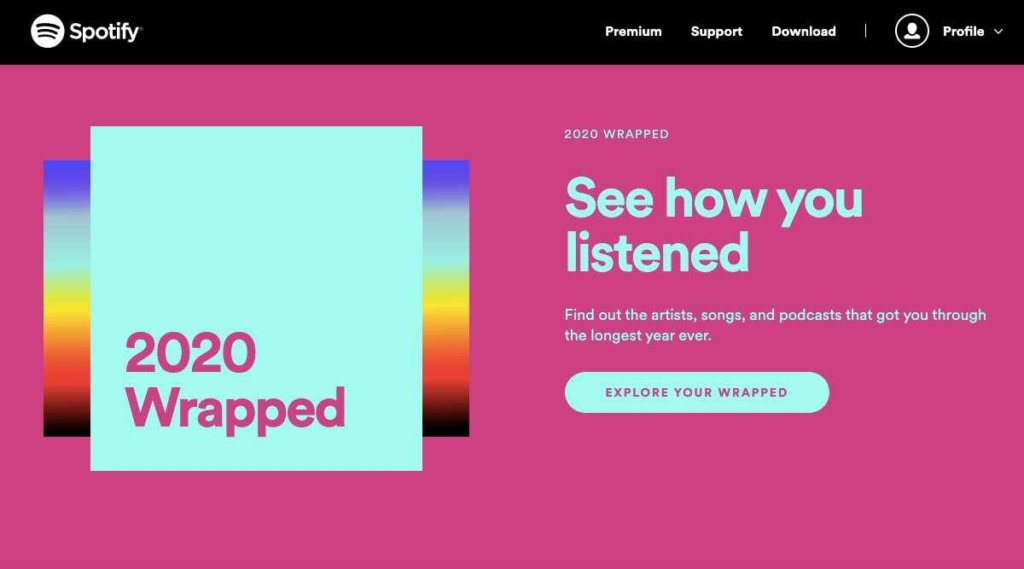
If you have any form of social media, you’ll likely remember this campaign flooding your feed, and maybe you even took part in it. At the end of 2020, Spotify allowed its customers to see their year of music with “2020 Wrapped”, which compiled their listening into a lovely array of photos and stats. Viewers loved seeing their personal data compiled into a nicely packaged marketing piece – and loved sharing their interests with others. Smart on Spotify’s end, because it not only gave them free marketing, but boosted their recognition.
So, What Have We Learned?
If you haven’t noticed, most of these campaigns share one key factor; relatability. How can you use relatability to create effective campaigns, too? Know your audience. Before even starting to brainstorm a campaign, make sure you’re fully aware of who, where, and when you’re targeting. And when you do start your campaign based off your findings, use that data and understanding to carefully craft consistent messaging that includes clear call-to-actions and personalized, catered content. Use hashtags, giveaways, QR codes, PURLs, BRCs, and more to engage with your audience and include them in your campaign. And, when and if appropriate, sprinkle in some humor.
Interested in making an impactful, relatable campaign that can help boost your company’s marketing efforts? Not sure exactly where to start? Look no further. Strata’s here to help. Contact us today to get the brainstorming started.
All Your Questions Answered
There’s a lot of buzz around new mover marketing and the best ways to target potential new customers. And with all the attention and noise around it, the topic can get confusing and leave a lot of essential questions unanswered. Today, we’re going to answer all your questions about new mover marketing – and give you some insight into how to start a successful and smart new mover campaign.
Why should I target new movers in the first place?
Easy answer. With over 13% of Americans moving ever year, a ton of new movers are not only new to your area, but are looking for your business. They’re in a stage where they’re starting to develop what will become habitual shopping/buying habits and not looking for a reason to spend, but where to spend. Recent surveys show that 80% of new movers are willing to try new products since they’re in a new market and searching for new businesses and services. Also, how else are you going to replace those long-term, current clients that are moving out of your market area?
In what industries is new mover marketing effective?
Movers moving into a new house spend on average, $9,400 post-move, and that’s split into several different industries depending on the individual. When people move to new areas, they have several new (and already existing) needs that can only be met by several different industries. This means a new grocer, new healthcare provider, new dentist, new restaurants, a new gym… list goes on and on (and on).
Is it possible to segment who I target?
Yes, you can segment who you’re targeting based off age, demographic, and even by household income, to identify your ideal customer profile. The level of available segmentation depends on your new mover marketing partner and the technology that’s provided, but it can (and has been) done.
Can I have more than one touch point across several channels?
Absolutely! We recommend implementing multiple touch points that come from different angles. This means reaching your customers through several different channels, such as digital, direct mail, and email. All of these channels of communication, used together and correctly, are proven to show effective ROI.
How can I grow my new mover market through direct mail?
With around 61% of customers finding direct mail influential in making purchasing decisions, it’s important to make it one of the cornerstones of your new mover marketing campaigns. Direct mail can be personalized for the consumer, be authentic to your brand, and provides opportunity to be creative with how you market products and services to your consumers. Mailers that typically work best for new movers are dimensional mail, postcards, and bi-folds with incentive items.
How can I grow my new mover customer base with digital ads?
Hand in hand with direct mail, digital ads are excellent in getting your company’s name across your potential customer’s device. Creating display and banner advertisements is an effective way to send customers to your website or to a specific landing page. The power of digital marketing often speaks for itself, so it’s important to have elements of it involved in your new mover marketing campaign to reach all potential customers – not just some.
What kinds of responses should I expect throughout my campaign?
This all depends on the structure of your campaign and what kind of responses you’re aiming for. For instance, if you include a business reply card (BRC) within your direct mailer, your response rate will be based off how many potential customers fill them out and return them. Furthermore, the more aggressive your offer is for a direct response, the greater the response will be. Responses typically vary between industry and how many different touch points are built into your campaign. Response rates can also be determined by digital ads based off the number of consumers that interact with your landing page by clicks or submitted forms.
What’s the best way to track responses from my campaign?
When executing a new mover marketing campaign, make sure the program you’re using can easily track all progress, responses, and data that comes with the campaign. Find a partner with access to technology that allows you to see real time responses for your campaign and gain intelligence from those responses to make adjustments as it’s executed.
How do I effectively set up a new mover marketing campaign?
Picking the right partner is everything when it comes to successfully setting up a new mover marketing campaign. The right partner will provide the right data, the right technology, and a partnership with strong content creators who will represent your brand correctly. Work with a company that understands your markets and has several years of experience.
Looking for ways to incorporate a new mover marketing strategy into your next campaign? Here at Strata, we have years and years (and years) of experience under our belts. We’re here to assist you with all your new mover marketing questions and needs. Contact us today.


